1656
Views & Citations656
Likes & Shares
Objectives of the Study
To evaluate the impact of political, economic, social, and technological factors on the capacity of institutions to manage tourism in Myanmar.
To analyze the influence of political, economic, social, and technological factors on the sustainability of tourism destinations.
To investigate the mediating role of institutional capacity in the relationship between external factors and sustainable tourism.
Research Questions
What is the impact of political, economic, social, and technological factors on the institutional capacity to manage tourism in Myanmar?
How do these factors influence the sustainability of tourism destinations?
How does institutional capacity mediate the relationship between these external factors and sustainable tourism in Myanmar?
Research Gap
While sustainable tourism has gained attention in academic research, there is limited focus on the role of institutional capacity as a mediating factor in tourism destination management, particularly in developing countries like Myanmar (Morgan & Qualman, 1996). Existing studies primarily address external influences such as political instability or economic conditions but often overlook the institutional mechanisms needed to respond to these challenges (Sharpley, 2000). Furthermore, Myanmar's unique socio-political context and its untapped tourism potential remain underexplored in sustainable tourism literature. This research seeks to address these gaps by integrating institutional theory with sustainable tourism practices, focusing on how institutional capacity mediates the impact of external factors on sustainable tourism (Lwin, 2021).
Significance of Study
This study emphasizes institutional capacity in long-term sustainable tourism management, adding to theoretical and practical understanding. The findings offer Myanmar policymakers and industry stakeholders actionable recommendations to strengthen institutional frameworks and promote public, private, and community collaboration. The study adds to the literature on sustainable tourism in developing countries by revealing institutional capacity's mediating role (Wilson & Patel, 2023). This research addresses Myanmar's tourism sector's challenges to inform adaptive policies, capacity-building, and strategic planning to ensure tourism destinations' resilience and sustainability.
LITERATURE REVIEW
Institutional Capacity in Tourism Management
Organizations and systems' institutional capacity is their ability to manage resources, implement policies, and achieve sustainability. Tourism management institutional capacity includes governance, stakeholder collaboration, financial resources, and technical expertise (Morgan & Qualman, 1996). For sustainable tourism management, especially in developing countries with governance issues, strong institutional frameworks are essential (Willems, 2016). The sustainability of tourism destinations depends on public and private tourism institutions. Many DMOs implement policies, coordinate stakeholders, and promote sustainable practices (Harry & Kate, 2021). However, weak institutional capacity-manifesting as inadequate skills, poor coordination, and lack of financial support-remains a critical barrier to achieving sustainable tourism in many regions, including Myanmar (Lwin, 2021).
Sustainable Tourism: Definitions and Challenges
Sustainable tourism is defined as tourism that meets the needs of present tourists and host regions while protecting and enhancing opportunities for the future (Sharpley, 2000). It aims to balance economic growth, environmental conservation, and socio-cultural preservation. Key principles of sustainable tourism include minimizing negative impacts, involving local communities, and fostering long-term resilience (UNWTO, 2020). Despite its potential, achieving sustainable tourism is fraught with challenges. In Myanmar, systemic issues such as political instability, limited infrastructure, and underdeveloped human resources impede progress (Wilson & Patel, 2023). The lack of strategic planning and inadequate enforcement of environmental policies further exacerbate these challenges, highlighting the need for stronger institutional frameworks.
Political, Economic, Social, and Technological (PEST) Factors
The PEST framework offers a comprehensive lens to examine external factors influencing tourism sustainability:
Political Factors: Political stability is crucial for tourism development, as instability, conflict, and negative perceptions can deter tourists (Chaitanya, 2021). In Myanmar, political instability has often undermined tourism growth, creating challenges for destination management (Lwin, 2021).
Economic Factors: Tourism’s economic contributions are significant, accounting for millions of jobs globally and a substantial share of GDP (UNWTO, 2020). However, economic challenges such as currency fluctuations, inflation, and limited investment in infrastructure can constrain tourism development (Orhan & Onur, 2019).
Social Factors: Tourism’s social impact includes both opportunities for cultural exchange and risks such as the erosion of cultural heritage and community displacement (Todd, 2022). Sustainable tourism emphasizes community involvement and equitable distribution of benefits to ensure long-term social acceptance (Jun, Wen, et al., 2023).
Technological Factors: Technology has revolutionized tourism through innovations like online booking systems, mobile apps, and data analytics (Buhalis, 2003). In Myanmar, however, the adoption of advanced technologies remains limited, posing challenges to competitiveness and sustainability (Haseeb, 2017).
Institutional Capacity as a Mediator
Institutional capacity mediates PEST factors and sustainable tourism. Strong institutions can mitigate political instability, economic constraints, and social issues while using technology to improve tourism management (Kotler & Armstrong, 2010). Effective policies and stakeholder collaboration can address resource allocation disparities, ensuring sustainable tourism destinations. PEST factors impact institutional capacity, requiring targeted capacity-building. Tourism professional training, infrastructure investment, and public-private-community partnerships (Maha, Mohani & Ahmad, 2023). Myanmar must strengthen institutional capacity to address systemic issues and sustain tourism.
Gaps in Literature
PEST factors have been extensively studied on tourism, but institutional capacity has not. Tourism sustainability studies often focus on political instability or economic growth rather than PEST factors. Myanmar's unique sociopolitical context and tourism potential are underexplored. The mediating role of institutional capacity in Myanmar's tourism sector is examined in this study to fill these gaps and provide a holistic understanding of sustainable tourism development challenges and opportunities.
Conceptual Framework and Hypotheses Development
The study links PEST, institutional capacity, and sustainable tourism. Management capacity mediates external environmental factors on Myanmar tourism. The framework uses theory and literature to show how macro-environmental and organizational factors affect sustainability. PEST-analyzed macroenvironments affect tourism. Policy, governance, and political stability impact tourism planning and operations. A stable political environment with supportive policies promotes growth, while instability and weak governance hinder it. Financial incentives, market conditions, and investment determine sector viability and competitiveness. Economic constraints and uneven growth may harm sustainability. Cultural values, community engagement, and tourism attitudes are needed for inclusive tourism. Digital tools, infrastructure, and data analytics enhance tourism, efficiency, and sustainability. Institutions facilitate PEST and sustainable tourism. Organizations, governments, and stakeholders use institutional capacity to manage resources, implement policies, and adapt to external changes. Governance, infrastructure, and human capital matters. Institutional capacity requires skilled staff, sufficient financial and physical resources, and transparent decision-making. Strengthening these capacities helps tourism survive external challenges and seize opportunities. This sustainable tourism framework balances economic benefits, environmental protection, and socio-cultural integrity. Improve economic resilience, preserve culture and biodiversity, and give local communities equal tourism benefits. Matching macro-environmental factors with institutional capacity helps Myanmar overcome its challenges and build a sustainable tourism sector. Institutional capacity will determine Myanmar's tourism future. The study educates policymakers, stakeholders, and development agencies about PEST and organizational mechanisms. Sustainable tourism in academia and Myanmar tourism benefit from this approach.
Conceptual Framework (Figure 1)
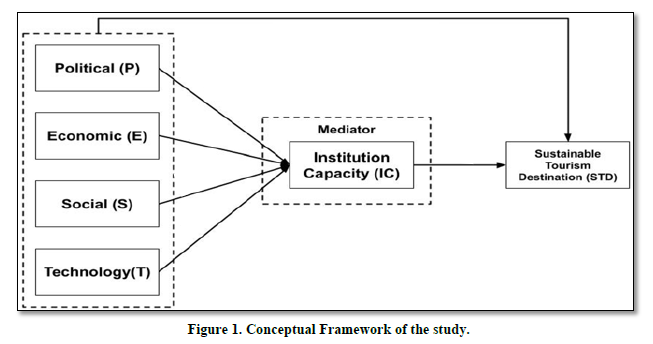
This framework identifies three key components:
Independent Variables (PEST Factors): Political, economic, social, and technological factors represent the macro-environmental elements influencing the tourism sector.
Mediating Variable (Institutional Capacity): Institutional capacity, encompassing governance, resource management, stakeholder collaboration, and capacity-building initiatives, is a critical mechanism for managing external challenges and leveraging opportunities.
Dependent Variable (Sustainable Tourism): Sustainable tourism reflects the balance between economic growth, environmental preservation, and socio-cultural well-being.
The framework posits that PEST factors directly influence institutional capacity and sustainable tourism outcomes, while institutional capacity mediates the relationship between PEST factors and tourism sustainability. This mediating role underscores the importance of robust institutions in managing tourism development effectively.
Hypotheses Development
Based on the conceptual framework, the following hypotheses are proposed:
- H1: Political factors have a significant positive impact on institutional capacity.
- H2: Economic factors have a significant positive impact on institutional capacity.
- H3: Social factors have a significant positive impact on institutional capacity.
- H4: Technological factors have a significant positive impact on institutional capacity.
- H5: Political factors have a significant positive impact on sustainable tourism.
- H6: Economic factors have a significant positive impact on sustainable tourism.
- H7: Social factors have a significant positive impact on sustainable tourism.
- H8: Technological factors have a significant positive impact on sustainable tourism.
- H9: Institutional capacity mediates the relationship between political factors and sustainable tourism.
- H10: Institutional capacity mediates the relationship between economic factors and sustainable tourism.
- H11: Institutional capacity mediates the relationship between social factors and sustainable tourism.
- H12: Institutional capacity mediates the relationship between technological factors and sustainable tourism.
These hypotheses reflect the interconnected dynamics within the tourism sector, emphasizing the critical role of institutional capacity in mediating external influences and enhancing sustainability.
METHODS
Research Design
This quantitative study examines Myanmar's institutional capacity, PEST factors, and sustainable tourism. For objective variable measurement and statistical evaluation, the quantitative approach allows structured data analysis. Since it uses only numerical data, the study is reliable, generalizable, and replicable. To measure institutional capacity's mediating role and external factors' direct and indirect effects on tourism sustainability, the design was chosen.
Sampling and Data Collection
The study targeted diverse Myanmar tourism stakeholders. These included tourism managers, operators, government officials responsible for tourism policy, tourism-related institution employees, and visitors to popular domestic tourism destinations. To ensure stakeholder and geographic representation, stratified random sampling was used. This method reduces sampling bias and improves findings. Based on statistical power analysis, 400 respondents were sampled. This sample size allows for reliable statistical analyses despite non-responses or incomplete data. A structured questionnaire was used to collect data on demographics, PEST factors, institutional capacity, and sustainable tourism outcomes. Each section included questions to gather respondents' thoughts and experiences. A five-point Likert scale (1 = Strongly Disagree, 5 = Strongly Agree) was used to assess statement agreement.
Data Screening and Preparation
Before analysis, the data was thoroughly screened for quality and reliability. To maintain analysis integrity, missing data were reviewed and cases with excessive omissions were excluded. Outliers were identified using z-scores and Mahalanobis distance and addressed. Skewness and kurtosis values were tested for normality to ensure data met statistical analysis assumptions. The Variance Inflation Factor (VIF) was used to assess multicollinearity among predictor variables to ensure independence.
Data Analysis
The study analyzed data using statistical methods. First, descriptive statistics were used to summarize respondents' demographics and their views on PEST factors, institutional capacity, and sustainable tourism outcomes. EFA and CFA validated constructs and ensured measurement accuracy, while Cronbach's alpha assessed questionnaire reliability by measuring internal consistency. SEM tested research hypotheses. SEM analyzes multiple variables and paths simultaneously, making it ideal for complex relationships. The analysis examined how institutional capacity mediates PEST effects on sustainable tourism. The Chi-square statistic, CFI, RMSEA, and Tucker-Lewis Index evaluated the SEM model's fit.
Ethical Considerations
The study's design and execution followed strict ethical guidelines. All participants received detailed information about the study's purpose and objectives and gave informed consent. The respondents were assured that their personal data would be kept confidential and anonymized. The relevant institutional review board gave the study ethical approval, ensuring compliance with human participant research guidelines.
FINDINGS
Descriptive Analysis (Table 1)

The descriptive analysis of the study sheds light on respondents' views of PEST factors, institutional capacity, and sustainable tourism in Myanmar. The results show tourism stakeholders' diverse perspectives, highlighting strengths and weaknesses. Respondents rated political factors neutral to slightly negative with a mean score of 3.02. This suggests political instability and governance issues are hindering Myanmar's tourism sector. Different political experiences affect tourism operations and policymaking, as shown by the moderate standard deviation of 0.82706. Economic factors were rated higher, with a mean score of 3.73, indicating that respondents recognize tourism's economic potential to create jobs and boost GDP. However, the standard deviation of 0.87626 suggests that economic issues like infrastructure investment and tourism development may influence perceptions. Social factors had a high mean score of 3.68, suggesting respondents value tourism's cultural and community benefits. Cultural exchange and community involvement are essential for the sector's long-term sustainability. The standard deviation of 0.78282 indicates stakeholder consensus, but perceptions may vary due to exposure to community-focused tourism practices. Technological factors had the lowest mean score, 3.00, indicating neutral perceptions. This suggests Myanmar's tourism sector is underusing advanced technology like digital marketing, booking systems, and data analytics. The moderate standard deviation of 0.85003 suggests that some respondents see technology's potential, but others see significant gaps in its use. A mean score of 3.49 indicated moderate institutional capacity. This suggests that institutional frameworks and governance mechanisms are somewhat effective, but stakeholder coordination, policy implementation, and resource management could be improved. The low standard deviation of 0.77434 indicates that respondents understand Myanmar's tourism sector's institutional challenges. Sustainable tourism scored highest, with a mean score of 4.09, indicating strong support for its importance and practices. The sector's ability to balance economic growth, environmental protection, and socio-cultural well-being is likely acknowledged. The low standard deviation of 0.75003 shows that stakeholders agree on sustainable tourism initiatives. Myanmar's tourism sector, particularly social and sustainable tourism, has strengths, but political stability, technological adoption, and institutional capacity need improvement. These findings lay the groundwork for targeted interventions and policy strategies to address challenges and capitalize on sustainable tourism development opportunities in the country
Correlation Analysis (Table 2)
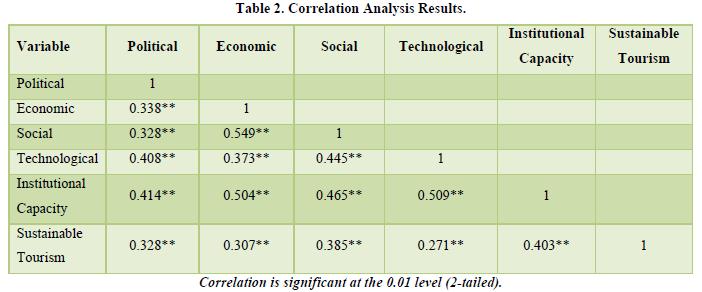
Political, economic, social, and technological (PEST) factors, institutional capacity, and sustainable tourism are correlated. All correlations are 0.01-significant, indicating statistically significant associations between variables. Political factors positively affect all variables. Political stability and good governance strengthen institutions, as institutional capacity has the strongest correlation (r = 0.414). The moderate correlation with sustainable tourism (r = 0.328) suggests that institutional capacity may mediate political factors' effects. Economic factors correlate positively with other variables, most strongly with institutional capacity (r = 0.504). Economic resources and investments are crucial to building strong tourism management institutions. Economic factors contribute to tourism sustainability indirectly and may depend on institutional frameworks (r = 0.307). Social factors strong positive correlate with institutional capacity (0.465) and sustainable tourism (0.385). Social dynamics like community involvement and cultural preservation are crucial to institutional strength and tourism sustainability. Social factors correlate significantly with technological factors (r = 0.445), indicating that tourism practices depend on social engagement and technological adoption. Technological factors positively correlate with all variables, but institutional capacity is strongest (r = 0.509). Technology is needed to improve institutional mechanisms like resource management and stakeholder collaboration. Technology may support sustainability, but its direct impact on sustainable tourism is weaker (r = 0.271). Institutional capacity correlates positively with all variables, especially economic and technological factors (r = 0.504 and 0.509). These findings show that economic and technological resources strongly influence institutional strength. Sustainable tourism (r = 0.403) mediates external factors into sustainable outcomes. Sustainable tourism has positive correlations with all variables, with the strongest being with social factors (r = 0.385) and institutional capacity (r = 0.403). This suggests that social dynamics and institutional strength drive tourism sustainability. Political, economic, and technological factors have weaker correlations (r = 0.328, 0.307, and 0.271), suggesting that institutional capacity and social engagement mediate their indirect influence. Institutional capacity is a key variable, correlated with all PEST factors and sustainable tourism. This confirms its crucial role as a mediator between political, economic, social, and technological factors and sustainable tourism outcomes. Strong institutional frameworks help manage resources, coordinate stakeholders, and implement sustainable tourism policies. Social factors strongly impact institutional capacity and sustainable tourism. Community and cultural factors are crucial to tourism development. Social engagement and cultural heritage preservation strengthen institutional mechanisms and ensure that tourism practices match local values and needs, promoting long-term sustainability. Technological and economic factors aid the framework. While their direct impact on sustainable tourism is relatively weak, their strong influence on institutional capacity underscores their importance in providing the resources and tools necessary for effective governance. Infrastructure and technology investments improve management and operational efficiency, indirectly supporting sustainable tourism. Political factors have moderate direct effects on sustainable tourism, though correlated with other variables. Stable governance and policy frameworks are crucial to tourism sustainability, as their influence is likely channeled through institutional capacity. Addressing political instability and governance issues could strengthen institutions, fostering sustainable tourism.
Reliability and Validity Analysis (Table 3)
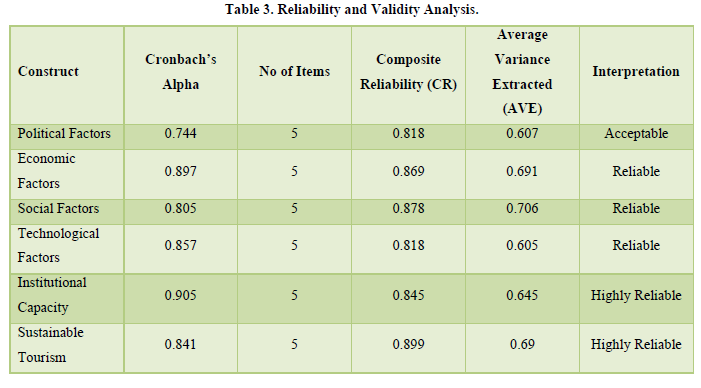
The reliability and validity analysis evaluate study constructs' internal consistency and measurement accuracy. Results show that all constructs meet or exceed reliability and validity thresholds, proving measurement scale robustness. Political factors' five items have a Cronbach's Alpha of 0.744, indicating good internal consistency. Composite Reliability (CR) of 0.818 and Average Variance Extracted (AVE) of 0.607 indicate that the construct captures over 60% of indicator variance. These findings show that this study accurately measures political factors. Cronbach's Alpha of 0.897, above 0.7, indicates economic reliability. The construct's CR of 0.869 and AVE of 0.691 support reliability and convergent validity. These values demonstrate this construct's robustness by measuring economic factors consistently and capturing significant variance. Social factors have 0.805 Cronbach's Alpha, indicating good internal consistency. The construct's CR of 0.878 and AVE of 0.706 exceed recommended thresholds, proving reliability and validity. Results show social factor items accurately represent this construct. Technological factors' Cronbach's Alpha is 0.857, representing high reliability. With indicators explaining over 60% of variance (CR = 0.818, AVE = 0.605), the construct is reliable and valid. This shows that technological factors are measured consistently and accurately. Institutional capacity has the highest Cronbach's Alpha, 0.905, indicating internal consistency. The construct's CR of 0.845 and AVE of 0.645 confirm its reliability and institutional capacity measurement accuracy. These findings show that this construct captures governance and resource management well. Cronbach's Alpha is 0.841 for sustainable tourism, indicating strong internal consistency. The construct's CR of 0.899 and AVE of 0.69 confirm its reliability and ability to represent sustainable tourism outcomes. These values indicate that the construct accurately measures the concept and captures a significant portion of its indicator variance. Reliability and validity analysis show all constructs have good measurement properties. Cronbach's Alpha values above 0.7 for all constructs indicate acceptable to high internal consistency, ensuring items measure their intended dimensions. The scales' Composite Reliability (CR) values exceed 0.7 for all constructs, proving their reliability and suitability for the study. All constructs have AVEs above 0.6, indicating robust convergent validity. The measurement models are well-specified and meaningful because the constructs capture a significant proportion of indicator variance. With the highest reliability and variance explained, institutional capacity and sustainable tourism are strongest. Because institutional capacity mediates and sustainable tourism is the study's result, these findings are important. These findings show the constructs' reliability and validity, supporting their use in analyzing the study's complex relationships.
The Model Fit Indices Analysis (Table 4)
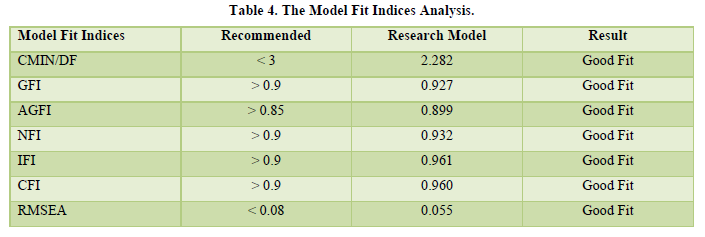
Study's Structural Equation Modeling (SEM) framework fits data well, according to model fit indices. All reported indices meet or exceed recommended thresholds, confirming measurement and structural model accuracy. Model complexity relative to fit is acceptable at 2.282, below the recommended 3. The model appears to balance parsimony and explanatory power. The GFI value of 0.927 exceeds the recommended threshold of 0.9, indicating that the model explains a lot of data covariance. This shows that the paths and constructs represent the observed relationships well. The AGFI value of 0.899 is slightly below 0.9 but above the minimum threshold of 0.85, indicating a good fit. The AGFI accounts for model complexity to adjust the GFI, demonstrating that the fit is robust even when penalized for additional parameters. The NFI value of 0.932 exceeds 0.9, showing that the model outperforms a baseline model without relationships. This shows how well the specified paths explain the data. The IFI value of 0.961 exceeds the recommended 0.9 threshold, indicating a significant incremental improvement over the null model. This suggests the model captures variable relationships well. A strong fit is indicated by the CFI value of 0.960, which is above 0.9. The CFI accounts for sample size, making it a reliable indicator of model adequacy. The RMSEA value of 0.055 is below 0.08, indicating a good fit. The model approximates observed data with minimal error, confirming its suitability for analysis. The model fit indices show that the SEM framework accurately depicts construct relationships. All key indices exceed their thresholds, indicating that the model is well-specified, parsimonious, and can explain the data. This strong model fit supports the study's theoretical and empirical framework and reliability.
Regression Analysis (Table 5)
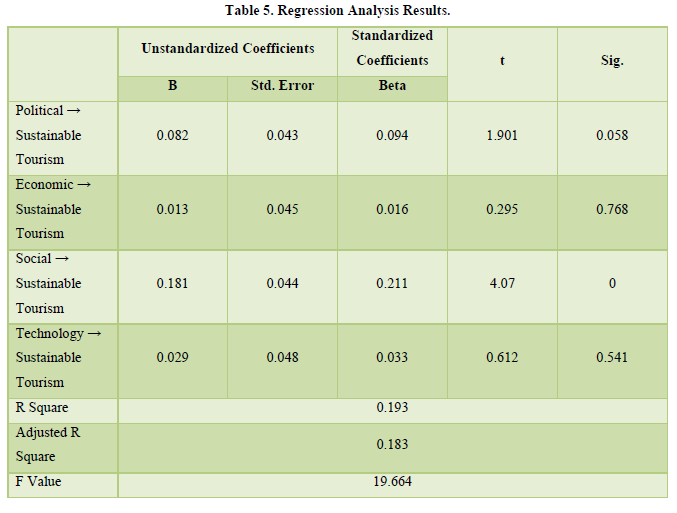
The regression analysis shows how political, economic, social, and technological factors affect sustainable tourism. Social factors are the strongest predictor, with a standardized coefficient of 0.211 and a significant p-value (< 0.001). Community engagement and cultural preservation are essential to sustainable tourism. The findings stress the importance of social factors in tourism planning for long-term sustainability. A standardized coefficient of 0.094 shows that political factors slightly benefit sustainable tourism. The relationship is insignificant at 0.05 (p = 0.058). In this model, political stability and governance may affect tourism sustainability, but they may need mediating variables like institutional capacity to have a greater impact. Economics and technology have negligible and statistically insignificant effects on sustainable tourism (standardized coefficients of 0.016 and 0.033). These findings suggest that economic resources and technological advances alone may not be enough to drive sustainability outcomes and require strong institutional mechanisms. The R Square value shows that the model explains 19.3% of sustainable tourism outcomes, with an adjusted R Square of 18.3% for model complexity. The model's 19.664 F-value proves its statistical reliability in explaining sustainable tourism outcomes. These findings emphasize the importance of prioritizing social factors while addressing governance, economic, and technological gaps. To understand and improve sustainable tourism development, they recommend exploring additional mediators like institutional capacity.
Impact of Political, Economic, Social, Technology on Sustainable Tourism Destination (Table 6).
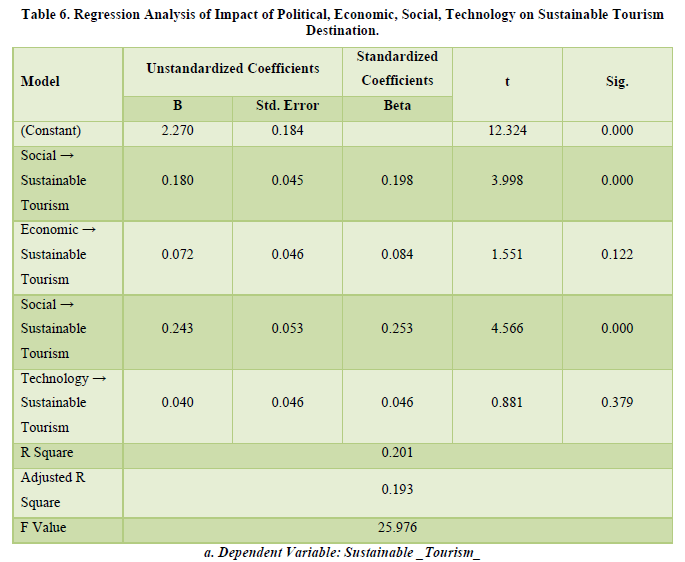
The regression analysis examines social, economic, and technological factors in sustainable tourism. The model's results reveal these relationships' strength and regression's explanatory power.
Sustainable tourism starts at 2.270 when all independent variables are held constant. This shows Myanmar's positive view of sustainable tourism. The baseline level seems statistically significant with a t-value of 12.324 (p < 0.001).
Social factors positively affect sustainable tourism the most, with an unstandardized coefficient of 0.243 and a standardized coefficient of 0.253. A significant t-value of 4.566 (p < 0.001) indicates that community involvement and cultural preservation are crucial for sustainable tourism. A lower but significant relationship (β = 0.198, t-value = 3.998, p = 0.000) indicates a consistent impact of social factors across perspectives.
Economic factors have a weak positive effect on sustainable tourism (0.084 standardized, 0.072 unstandardized). Statistically, the relationship is insignificant (t-value 1.551, p = 0.122). This suggests that economic factors alone may not drive sustainable tourism outcomes and may need institutional mediation or other support.
Technological factors affect sustainable tourism minimally, with a standardized coefficient of 0.046 and an unstandardized coefficient of 0.040. The t-value of 0.881 (p = 0.379) shows that technology, while potentially useful in tourism development, does not directly affect sustainability outcomes in the current context. R Square shows that the regression model explains 20.1% of sustainable tourism outcomes. The adjusted R Square of 19.3% accounts for model complexity and suggests that independent variables explain nearly 20% of sustainable tourism variation. The model's statistical reliability is confirmed by a significant F-value of 25.976 (p < 0.001). Social factors, particularly cultural and community engagement, drive sustainable tourism, according to the analysis. Economic and technological factors have little direct impact on sustainable tourism, suggesting they may be mediated by institutional capacity. The model has moderate explanatory power, suggesting more variables or mechanisms are needed to fully capture sustainable tourism drivers.
Mediating Role of Institutional Capacity in Sustainable Tourism Destination Management: Path Analysis Across Political, Economic, Social, and Technological Factors (Table 7).
Hypotheses testing show significant relationships between institutional capacity, political, economic, social, and technological factors, and sustainable tourism. Direct effects show that all external factors affect sustainable tourism, while their effects vary. Political factors positively impact sustainable tourism (β = 0.1112, p < 0.0001) and institutional capacity (β = 0.1672, p < 0.0001), emphasizing the benefits of stable governance and institutional frameworks. Economic factors significantly impact sustainable tourism (β = 0.2006, p < 0.0001) and institutional capacity (β = 0.3152, p < 0.0001), highlighting the importance of financial resources and investments in building sustainable tourism and strong institutions.
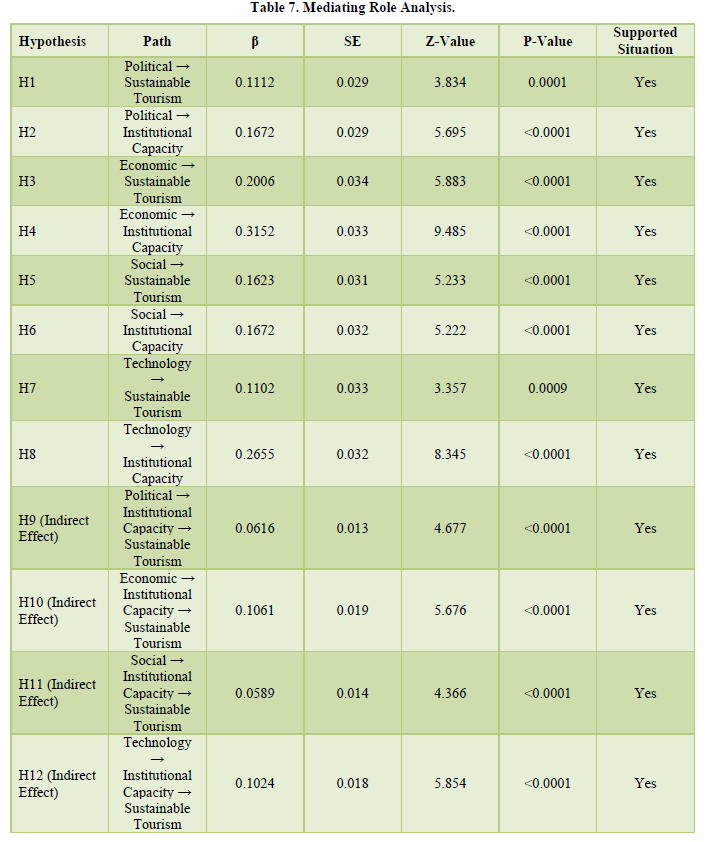
Social factors significantly affect sustainable tourism (β = 0.1623, p < 0.0001) and institutional capacity (β = 0.1672, p < 0.0001), emphasizing the importance of community engagement and cultural preservation for governance and sustainability. Technological factors have a smaller impact on sustainable tourism (β = 0.1102, p = 0.0009) but a stronger impact on institutional capacity (β = 0.2655, p < 0.0001). Technology may support institutional mechanisms and sustainability indirectly.
The indirect effects emphasize institutional capacity's mediating role. Political factors indirectly impact sustainable tourism via institutional capacity (β = 0.0616, p < 0.0001), indicating that effective governance and policy reforms require strong institutions. Institutional capacity mediates the link between economic factors and sustainable tourism (β = 0.1061, p < 0.0001), highlighting its role in converting financial resources into sustainable outcomes. Social factors indirectly affect sustainable tourism through institutional capacity (β = 0.0589, p < 0.0001), emphasizing the importance of institutional mechanisms in leveraging social dynamics. Technological factors have a greater impact on sustainable tourism when supported by institutional frameworks (β = 0.1024, p < 0.0001).
Studies show direct and indirect pathways explain sustainable tourism outcomes. Institutional capacity mediates political, economic, social, and technological sustainability effects. Governance, resources, social engagement, and technology are interconnected, and robust institutional frameworks are needed to translate external influences into sustainable tourism practices.
DISCUSSION AND CONCLUSION
Discussion
This study links PEST factors, institutional capacity, and sustainable tourism. Social factors best predicted sustainable tourism, emphasizing community involvement, cultural preservation, and social equity. This supports literature on local communities as tourism ecosystem stakeholders. Community engagement can improve governance and resource management because social factors strongly influence institutional capacity.
Economic factors boosted institutional capacity but had little impact on sustainable tourism. This implies that economic resources, while necessary for infrastructure and investment, are most effective when channeled into sustainable practices by strong institutions. Technological factors had little direct impact on sustainable tourism but increased institutional capacity. Technology can improve institutional frameworks through digital resource management and stakeholder collaboration tools.
Political factors moderately affected sustainable tourism, but institutional capacity was more important. Stable governance and policy reforms foster institutional effectiveness, which supports tourism sustainability. Institutional capacity mediated all PEST factors, confirming its importance as a link between external influences and sustainable tourism outcomes.
The model explained 20% of sustainable tourism outcomes, suggesting that while the studied variables are important, environmental considerations, stakeholder dynamics, and market trends may help us understand tourism sustainability. These findings support previous research on sustainable tourism's complexity and the need for holistic solutions to systemic issues.
CONCLUSION
This study emphasizes the importance of PEST factors, institutional capacity, and sustainable tourism in Myanmar. Sustainability was most directly driven by social factors, emphasizing cultural and community engagement. Economy and technology have less direct impact on sustainability, but they strengthen institutional frameworks that mediate their effects. Political stability and governance reforms affect institutional capacity, making them crucial. Institutional capacity is key to sustainable tourism outcomes from external influences. Strong institutions amplify the positive effects of PEST factors, ensuring that resources, policies, and social dynamics are used effectively for long-term sustainability, according to the mediation analysis. These findings suggest that policymakers and stakeholders invest in capacity-building, encourage community participation, and integrate technology into institutional mechanisms. Finally, institutional capacity is a key enabler of sustainable tourism in Myanmar, as the study shows. Future research could add environmental and market variables to refine the model and provide a more holistic view of sustainable tourism development. Myanmar's tourism sector can adapt to changing conditions by addressing gaps and leveraging institutional strengths.
Limitations of the Research
This study provides illumination on PEST factors, institutional capacity, and sustainable tourism, but it has limitations. The research only covers Myanmar, so the results are context-specific. The results may not apply to other developing economies with different socio-political or economic conditions. Despite its statistical strength, the study is quantitative, which may lack qualitative depth and nuance. This method ignored stakeholder experiences, cultural differences, and governance practices, which are essential to understanding institutional and sustainability dynamics. The cross-sectional research design uses one-time data. This makes it hard to track trends and understand relationship between variables. A longitudinal approach may show how PEST factors and institutional capacity affect sustainable tourism over time. The study only considers political, economic, social, and technological factors, ignoring environmental and market dynamics that affect tourism sustainability. Self-reported data may be influenced by social desirability or subjective survey questions. While the study's constructions were reliable and valid, concepts like institutional capacity could use more granularity to capture their complexity and operationalize their sub-dimensions.
Recommendations for Future Research
To overcome these limitations and build on the findings, future research should expand geographically. Comparisons between similar studies in different regions or countries could improve generalizability. For instance, comparing developing and developed economies may reveal contextual differences in sustainable tourism practices. A mixed-methods approach using qualitative methods like interviews or focus groups would yield a more nuanced understanding of stakeholder perspectives and contextual influences. To better understand sustainable tourism, future research should include environmental sustainability, climate resilience, and market dynamics. A longitudinal design would allow researchers to observe relationship changes over time, revealing how PEST factors and institutional capacity affect tourism sustainability.
Exploring mediators and moderators like stakeholder collaboration and cultural diversity could help explain how PEST factors affect sustainable tourism. Institutional capacity's role in tourism management can be better understood by examining its sub-dimensions, such as financial resources, technical expertise, and stakeholder engagement. Finally, future research should examine how government agencies, private sector actors, and local communities affect institutional capacity and sustainable tourism. Future research can better understand sustainable tourism drivers and challenges by addressing these recommendations. Policymakers and practitioners can then develop more effective tourism sustainability and institutional resilience strategies in diverse contexts.
- Buhalis, D. (2003). eTourism Information technology for strategic tourism management. Pearson Education Limited.
- Chaitanya, K. (2021). Impact of political stability on tourism development. Journal of Tourism Research, 15,45-59.
- Harry, J., & Kate, L. (2021). Challenges and opportunities in Myanmar’s tourism sector. Asia Pacific Journal of Tourism Studies, 22, 123-140.
- Haseeb, M. (2017). Technological advancements in tourism management: A developing country perspective. Journal of Emerging Economies, 8, 45-60.
- Jun, Z., Wen, S. (2023). Community involvement in sustainable tourism A socio-cultural perspective. Tourism Review International, 28, 240-258.
- Kotler, P., & Armstrong, G. (2010). Principles of marketing. Pearson Education.
- Lwin, T. (2021). Institutional barriers to sustainable tourism in Myanmar. Journal of Southeast Asian Studies, 9, 78-95.
- Maha, M., Mohani, H., & Ahmad, S. (2023). Institutional capacity-building for sustainable tourism. Tourism Management Perspectives, 50, 101015.
- Morgan, R., & Qualman, C. (1996). The role of institutional capacity in tourism management. Journal of Tourism Policy, 5, 30-45.
- Orhan, T., & Onur, B. (2019). Economic drivers of tourism growth: A global perspective. International Journal of Economic Policy, 12, 75-89.
- Sharpley, R. (2000). Tourism and sustainable development Exploring the theoretical divide. Journal of Sustainable Tourism, 8, 1-19.
- Sharpley, R. (2009). Tourism development and the environment Beyond sustainability Earthscan Publications.
- Todd, E. (2022). Socio-cultural dimensions of sustainable tourism development. Tourism and Society, 18, 101-118.
- United Nations World Tourism Organization (UNWTO). (2020). Sustainable tourism A global perspective. UNWTO Publications.
- Willems, R. (2016). Institutional theory and tourism development. Journal of Institutional Studies, 11, 256-275.
- Wilson, R., & Patel, S. (2023). Sustainable tourism in developing economies Strategies for growth. Journal of Tourism Research and Practice, 34, 90-105.



